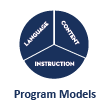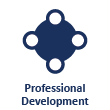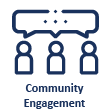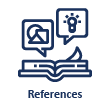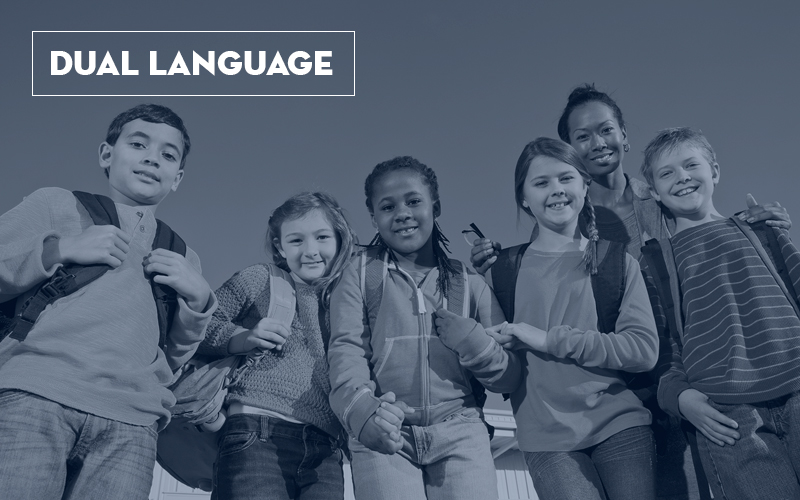
DC public and charter schools are currently implementing dual language programs where students are developing proficiency in two or more languages. DC School Report Card provides information about a school overall, including schools providing dual language/bilingual instruction.
DC Dual Language Roadmap
The District offers numerous public and public charter school options to choose from, and dual language has been a highly popular program offering where demand has vastly surpassed supply in DC for many years. This roadmap analyzes dual language programming in DC from 2015-16 through 2019-20, focusing on:
- Student enrollment patterns in dual language programs
- Performance and growth outcomes among students in dual language programs
- Demand for and equitable access to dual language programs
- Projected supply, demand, and enrollment
- Dual language program models and characteristics
- National approaches to dual language programming
- Performance measurement and program evaluation toward continuous improvement
Dual Language Roadmap Presentation: Use this presentation to find DC’s dual language characteristics and educational services provided in DC public and public charter school.
Dual Language Roadmap Appendices: This document includes detailed information about dual language programs in DC. The dual language program model definitions, data, findings, and recommendations in this report were the reference to create the dual language roadmap presentation.
Choose an icon below to find information about your area of interest.
Program Models
Dual language and bilingual instruction are offered in some DC public and charter schools where students have the opportunity to develop language skills and achieve proficiency in two languages. The majority of dual language programs in DC teach in English and Spanish, although there are schools that deliver instruction using a partner language other than Spanish, such as French, Chinese, and Hebrew.
In this section, you will find information about schools that offer dual language and bilingual instruction in grades pre-K through grade 12 and dual language program models.
This Dual Language Model one-pager provides basic information about dual language programs and features that can be shared with parents and community members.
Frequently Asked Questions (FAQs)
Q1: What are the goals of dual language programs?
For English learners, a dual language program provides an English language instruction educational program, while also developing their proficiency in their home language. For all students, the goals are:
- To become bicultural, bilingual and biliterate in English and a second language; that is, to develop proficiency in reading, writing, listening, and speaking in two languages as well as cross-cultural communication.
- To meet or exceed grade-level academic content standards and benchmarks in all subject areas, as defined by the Common Core State Standards.
Q2: What are dual language program types?
The two overarching types of dual language are one-way and two-way:
- Two-way has both students whose native language is the same as the target language and students whose native language is English learning in two languages. This model promotes the maintenance and development of students’ first language and the acquisition of a second language. It may be referred to as a 50-50 or 90-10 model, which refers to the percentage of instructional time that is in the partner language and in English.
- One-way models have students from one language background learning in two languages. This model often develops when a school consists of mostly English learners from the same language background. It promotes home language development, maintenance, and language restoration, in addition to developing English as a second language. It can also occur when most or all of the students are native English speakers learning the partner language.
Q3. What are the benefits of a dual language education program?
The National Academies of Sciences, Engineering, and Medicines’ 2017 report, Promoting the Educational Success of Children and Youth Learning English: Promising Futures, described the significant benefits derived from early language learning, as well as the potential long-term educational and career benefits that dual language students accrue. The goal is to provide all students, no matter their background, an equal chance to succeed and graduate. Some statements supported by research are:
- Language learning is beneficial for both monolingual English and English language learners in bilingual and dual language programs. (Pagan, 2005)
- Bilinguals often exhibit a broad set of advantages that include the ability to switch their focus of attention and reflect on the structure of language itself, a process known as metalinguistic awareness. (Beeman & Urow, 2008)
- There is a correlation between bilingualism and the offset of age-related cognitive losses. (Bialystok, Craik & Ryan,2006)
- Dual language programs provide English learners an opportunity to make faster-than-average progress on grade-level instruction. Native English speakers who are already on grade-level can exceed the achievement of their monolingual educated peers. For both groups, dual language instruction leads to enhanced creativity and critical thinking. (Collier & Thomas, 2004)
Q4. What is a content and language allocation plan?
The strategical assignment of instructional time to each language for specific content areas for each grade level is called a content and language allocation plan. Schools with dual language programs are required to have a content and language allocation plan that reflects students’ bilingual and biliterate trajectory.
In a dual language 50:50 program model, instructional time could be divided equally between English and the partner language from the first year of schooling. Another variation of a dual language program is known as 90:10. The students are immersed 90 percent of the instructional time in the partner language (not English) in early grades to gradually and structured incorporate instruction in English.
For specific information about the content areas and the language of instruction, contact your school and ask about the content and language allocation.
Q5. Are dual language programs appropriate for serving English learners (ELs)?
Yes. LEAs and schools may choose a dual language program to meet the federal obligation to serve ELs through a language instruction education program. Language development services for ELs can be delivered through dual language instruction. When dual language programs are research-based programs and grounded in sound educational theory that supports the development of English language proficiency, students are set up to achieve and be successful.
In addition to receiving instruction in the home or partner language within a dual language program, ELs must also be provided instruction that is designed to ensure that they:
- Develop academic English, so that English language proficiency is achieved within a reasonable length of time, and
- Meet the academic standards in all areas.
For more information, view English Learners Policies and Instructional Resources.
Professional Development
All TAL professional learning opportunities, including dual language courses and registration links, are announced in advance in OSSE’s learning management system (LMS) platform. The best way to stay informed of upcoming opportunities is to review the TAL PD Bulletin monthly newsletter.
Community Engagement
OSSE TAL created a Distance Learning Resource Guide for LEAs and families to support students in remote learning. Family distance learning resources can also be downloaded in English, Spanish, Amharic, French, Vietnamese, Korean, and Chinese. Visit the Distance Learning Resources for LEAs and Families webpage.
- Family Tools: Effective School-Home Communication: Modified from resources created by the Center for the Education and Study of Diverse Populations, this document for families addresses the importance of effective school-family communication. Parents, families and teachers are invited to consider their understanding of school programs and policies, student progress, how to respond effectively to students’ problems and how to improve communication with schools and community members. Family tools can also be downloaded in Spanish. Amharic, French, Vietnamese, Korean, and Chinese.
Resources
The US Department of Education, Office of English Language Acquisition, published in December 2015 an analysis of relevant research and extant data related to dual language education policies and practices. Learn more about expecting benefits for ELs, program definition and implementation.
Dual Language Handbook
District of Columbia Seal of Biliteracy
Common Core State Standards in Spanish
WIDA in Spanish
- Estándares del desarrollo del lenguaje español
- Los descriptores Podemos: Usos clave del lenguaje académico en español:
- Educación Temprana
- Kínder
- Primer Grado
- Segundo y Tercer Grado
- Cuarto y Quinto Grado
- Sexto a Octavo Grado
- Noveno a Doceavo Grado



